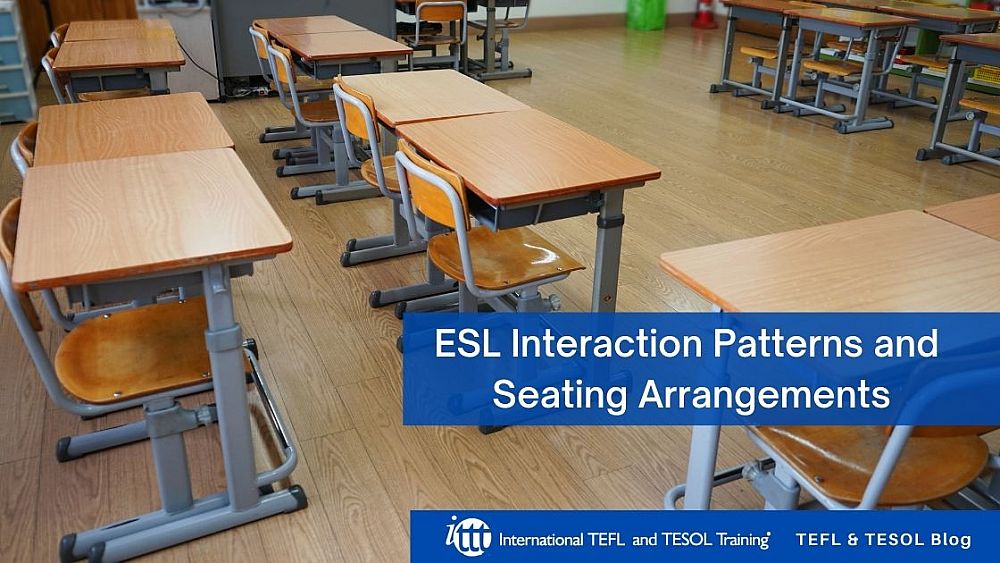ESL Interaction Patterns and Seating Arrangements

How the seats are arranged in a classroom can convey numerous implicit messages about the pedagogical approaches and methods employed in a specific school and the teacher who works there. A well-designed seating arrangement not only facilitates the interaction between the teacher and the learners but it also enables the students to interact together, which is a paramount feature of a student-centered class effectively. There is a wide variety of interaction patterns that each can be appropriately applied considering the aim and objective of a lesson and the ongoing task; however, a well-adjusted seating arrangement may pave the way for the flow of the information during the lesson and help the class make the most of the task and interacting opportunities.
Table of Contents
Are you ready to teach English abroad or online?
Check out what our course grads say in our many video testimonials!
Teacher-Students
Although this conventional teacher-students interaction pattern may appear to promote a teacher-centered approach with the teacher mostly positioned in front of the class and next to the board, it comes in handy while lecturing, providing the students with instructions or direct input, probably during the study phase. In this case, learners presumably require to be able to see the board and the teacher if need be; therefore, the propitious seating arrangement for this interaction pattern might be a U-shaped one, also known as a horseshoe layout, when the seats are arranged semicircularly around the classroom facing the board so that all the students are able to see the teacher and the board if the students are meant to be physically distanced from each other like during an exam or an outbreak on the same lines to the current situation deriving from the pandemic, a grid layout when the seats are located far from each other in straight columns and rows, can be taken into account.
Teacher-Student
This pattern comes in useful during a tutorial class or when the teacher feels the urge to focus on a specific student for any particular reason. Addressing a student to answer a question, provide feedback, reply to their queries by the teacher, and so forth are examples of teacher-student interaction. Regardless of the seating arrangement, this interaction pattern can be employed by basically getting close and interacting with the particular student in order to deal with the situation.
Student-Student
Pair work activities, when two students have the opportunity to do an exercise or put their heads together and share their ideas, are some frequently observed tasks in an ESL classroom. Students can be instructed to drag their seats closer to each other or just turn right or left and face the person next to them in order to fulfill the pair work activity and interact effectively. Arranging the seats two by two or in two columns facing each other or back to back can also ease the interaction during a pair work activity. The onion ring layout, when the seats are arranged in inner and outer circles and can be swapped in order to change partners more than once during the activity, may serve the purpose well depending on the task type.
Students-Students
Group work activities stimulate various students-students interaction patterns when learners have the chance to interact with more than one of their counterparts, with the teacher standing aside and monitoring the process. Enemy corners and opposing teams' seating arrangements are examples of appropriate layouts for group work activities. Furthermore, a circular seating arrangement for a whole class activity when students are sitting around a circle and the teacher keeps monitoring the task probably from a position out of the circle or sitting anywhere around the circle may provide students with the chance to promote eye contact together so as to get more assertive and less dependent on the teacher. Although there might be some blind spots in the classroom and some students might not be able to see the board or the teacher, this interaction pattern develops student-centeredness.
Student-Students
There might be occasions when a student is supposed to present something to the class or a specific group of students. In a case like this, the teacher may want to delegate the authority and take a back seat while a student or maybe some students are in charge of the activity or the group he/she is a member of. The teacher may choose to sit among the students, monitor the task, and make notes of possible errors without interrupting the process.
In Conclusion
In conclusion, apart from the aim and objective of a lesson and the tasks in progress, many other characteristics like the size of the classroom, the number of students, the school discipline, and so on are effective and required to be taken into account when it comes to selecting the most efficient interaction pattern and seating arrangement. Additionally, applying a wide variety of seating arrangements during a single lesson might be not only time taking but also boring for both students and the teacher.
Are you ready to teach English abroad or online?
Apply now & get certified to teach english abroad!
Speak with an ITTT advisor today to put together your personal plan for teaching English abroad!
Send us an email or call us toll-free at 1-800-490-0531 to speak with an ITTT advisor today.
Related Articles:
- Top 10 Cities in Europe with the Highest Demand for English Language Teachers
- 5 Reasons To Take A TEFL Course Right Now - Even If You Are Not Leaving Yet | ITTT | TEFL Blog
- All the Documents You Will Need to Teach English Abroad
- The Impact of Positive Motivation on an ESL Classroom
- You're Never Too Old to Change Your Life and Do a TEFL Course | ITTT | TEFL Blog
- Getting Student Placement Right - The Best Desk Arrangements for EFL Students



